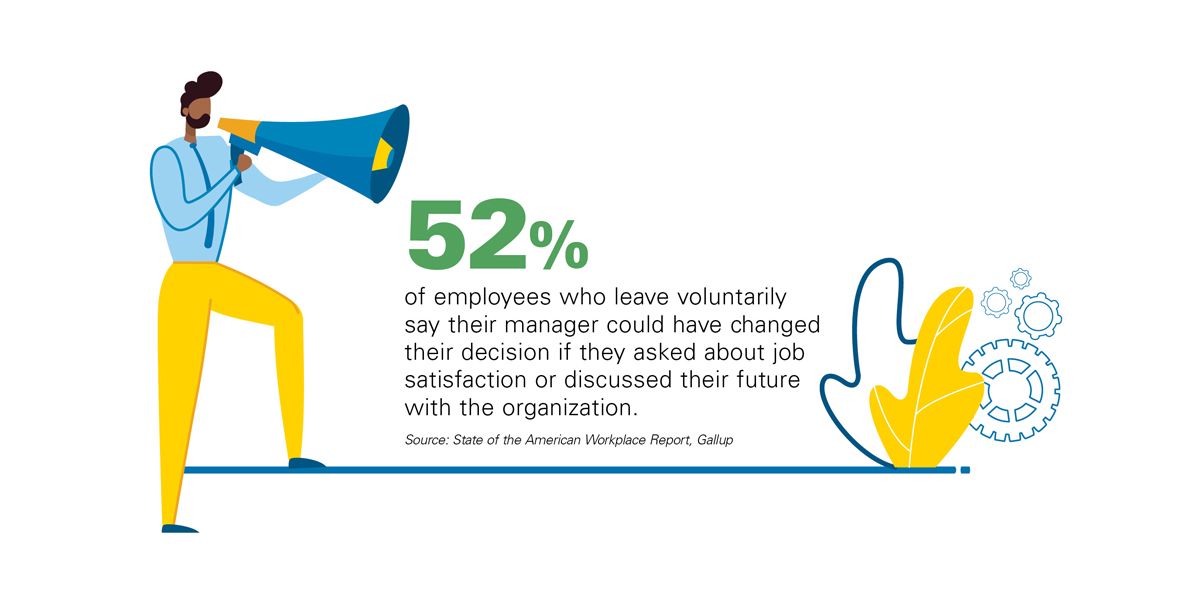Keeping quality employees is a perennial problem for retailers. Solutions for reducing turnover often focus on better hiring techniques, competitive pay, benefit packages and a healthy company culture. Recent research from analytics and data firm Gallup adds another important piece to the equation: managers make a difference.
According to the study, employees are more likely to stay when a manager is actively involved in their development and success.
“We have research that shows the manager being able to impact up to 70 percent of an employee’s engagement,” says Sam Acuna, managing consultant with Gallup. Engaged managers, and in particular those who operate more like coaches than top-down supervisors, lead to engaged employees, which results in higher productivity and reduced turnover.
To help you learn more about improving your management style and reducing turnover, Hardware Retailing editors spoke with Acuna and three retailers who have taken steps to improve employee retention.
What Employees Want
Gallup’s study, the State of the American Workplace, presents results of surveys from employees in a range of job sectors and all company sizes that gauged their attitudes toward their place of employment. The results show a disturbingly low level of engagement at work. About one-third of employees surveyed are engaged in their work—they love their jobs and want to make the organizations they work for better. The other two-thirds of employees are disengaged or, worse, they are doing damage to what other employees are building.
Engaged employees are more productive and are more likely to stay at their current jobs where they can make long-lasting contributions to their companies. They are also less likely to be looking for another job, the study shows. Replacing an employee who quits has a big price. Some of those costs can be quantified, such as recruiting fees or the hours it will take you to train the new hire. Other less tangible costs include loss of productivity, impact on morale of the other workers or the deferment of projects that might grow your business.

Of course, employees still place a high value on pay rate and benefits, but that isn’t telling the full story of why they may choose to look somewhere else for work. The Gallup poll indicates there’s a shift away from the top-down management approach to one that places high value on development.
“There is a change happening in what people expect out of the workplace. A job used to be about a paycheck; now people want a job with a purpose,” says Acuna. “People used to think of their manager as their boss; now they are looking for a coach. It’s not just about annual reviews; they want regular feedback, regular conversations.”
Managers who are coaches offer regular feedback and help employees develop. They understand that employees want a work-life balance and they may need some flexibility with their schedules. Managers who emphasize coaching understand the needs of their employees and that if they meet those needs, they will have happier, more productive workers and more engaged employees.
“Our study shows that employees who are supervised by highly engaged managers are 59 percent more likely to be more engaged than those supervised by disengaged managers. It’s a cascade effect,” Acuna says. “The more engagement there is at the top, the more it will trickle down to the bottom.”

How to Coach Employees
If changing from a commander style of management to a coaching approach is the way to keep employees around longer, how do you do it? Lean how three retailers have focused on employee development and manager engagement to tackle turnover.
Have an Organized Approach to Training
Elena Nelson faces a problem likely common to many urban retailers.
“Finding qualified people is a big problem. We usually hire three people hoping one of them will work out,” she says. “Retail isn’t a career to many of them, or they don’t understand how hard you have to work.”
As co-owner of Nicollet Hardware in Minneapolis, Nelson says a high turnover rate is an ongoing challenge. She has a core group of dedicated employees who have been with her six or more years. For the others, a tenure of more than a year is a success, she says. She estimates the cost of bringing on a new employee is around $3,400, and that doesn’t include diminished revenue from lost productivity.
Recently, Nelson has been making strides to reduce turnover rates. Her former approach to training had some weaknesses, she admits. New hires were expected to be self-starters who would search out opportunities to learn. Instead, the lack of structured training left many new hires frustrated and unengaged.
She tackled the issue by creating clear job descriptions and writing a new employee handbook so new hires could understand standard operating procedures. She also took a more organized approach to training that gave a clearer path for both the trainer and the new hire to ensure consistency in what employees were learning. Her approach blended both online courses and on-the-job mentoring.
“We developed a program to get employees trained quickly so they can start to feel helpful sooner,” she says. “We also have individual conversations with people to determine their strengths and what types of jobs best fit them.”
In addition to making employees happier, which has begun to reduce turnover, Nelson’s new approach to onboarding is resulting in more satisfied customers because they are interacting with more knowledgeable employees.
Training doesn’t stop after the initial onboarding phase, either. Acuna suggests employee development should be ongoing.
“Training is not the only way to invest in employees,” he says. “Development could also be an assignment that stretches them to grow. It could be a different role where they learn new skills. Get creative. Little moves can go a long way toward developing an employee.”
Managers who take a more active approach to training and development have a direct effect on turnover. According to the Gallup study, businesses in the top quartile of engagement, or those with the highest level of engaged employees, have a 24 percent lower turnover rate than those in the bottom quartile of engagement, or those with the lowest level of engaged employees.
Free Job Description Templates
Free Job Description Templates
Learn to Trust Employees
As the new owner of McCoy True Value in Indianola, Iowa, Jennifer Pfeifer-Malaney says she has been following the example for good employee management set by her father, Steve. When he unexpectedly died in 2015, Pfeifer-Malaney took over the business. Until then, she had no experience as a manager, but fortunately her father had developed a strong core of employees. Two have been with the company for more than 30 years; several others have tenures around 10 to 15 years.
“My dad really had a flair for being someone who was good with people, whether customers or employees,” she says. “That’s what helped make the business successful for so many years. He was good at delegating responsibility.”
Her father’s example of showing employees his trust in them by giving them responsibilities has had a big influence in Pfeifer-Malaney’s own management style throughout her transition to ownership.
She believes the reason many employees have been so loyal to the business is a direct result of her father’s leadership, she says. She’s been following her father’s model as she makes new hires and learns how to engage the current staff. As a starting point, she says it’s important to learn the strengths of each employee and find the best place where they could be used in the company.
“We have had employees who were hired for one job and then we see that’s not where they were the best fit,” she says. “Once we figure that out, we are able to move them to a different area.”
When you find where an employee fits in, or where their strengths lie, trust them to do their job, even when they slip. In fact, how you react to mistakes may be one of the most powerful statements you make about how much you trust them. Allow them autonomy to do their jobs and treat mistakes as learning opportunities. Pfeifer-Malaney says she chooses to assume employees want to do the right thing and that most mistakes are unintentional.
“We know that everyone makes mistakes,” she says. “Understanding that and knowing how to react to those mistakes shows the level of trust you have in your employees.”
Also, celebrate successes together. Positive feedback goes a long way toward developing a positive attitude among employees, she says. Acknowledging employees who do something well will foster longevity with the company as employees understand they are valuable to the team.
Teach the Staff Teamwork
Teach the Staff Teamwork
Get Serious About Feedback
At Home Building Centre Gravenhurst in Gravenhurst, Ontario, owners Stephen Collins and LeeAnne Gidwani lead nearly 50 employees, some of whom are seasonal staff. Turnover rate is around 10 percent, a testament to a careful hiring strategy as well as a management style that emphasizes the importance of regular feedback. It’s an approach they developed by necessity 10 years ago when Collins, then new to the business, was part of a rapid business expansion that included a significant increase in the number of employees.
“We built a new facility in 2010 and moved in with a staff of 28 and added 14 in that first year,” he says. “The first few years were a roller coaster. We were dealing with a lot of people with a long tenure in the business mixing in with a lot of new people.”
With such an influx of new people, Collins made changes to the company’s hiring practices and used a consultant to help with the process. He also placed a high importance on annual reviews. During the first quarter of each year, every employee gets a one-hour, one-on-one session with their immediate supervisor and ownership, in which they receive feedback about their performance and also have the opportunity to give feedback on their experience.

“This is one of the most important things we do to increase retention and engagement,” Collins says. “Each employee knows they get a voice and time behind a closed door when they can speak their mind. We encourage staff to share their thoughts.”
Having a scheduled, dedicated time for feedback, whether it involves reviewing job performance, addressing concerns or talking about future opportunities, will boost employee engagement. But for Collins, feedback doesn’t just happen once a year. With the company’s open-door policy, employees are always free to come and talk to management.
“Communication is important all year,” he says. “When we sit down at the annual review, there should be no surprises. If there are concerns, it’s important we deal with them in a timely manner.”
An issue with one employee can quickly spread if not dealt with promptly, and the result may be dragging down the rest of the staff. The timeliness of the feedback is just as important as its regularity. Give praise and encouragement too when it’s warranted. Don’t only give feedback when something goes wrong.
With three managers under his supervision, Collins says learning to give feedback, whether in the form of constructive criticism or a word of encouragement, is a skill that needs to be taught. It doesn’t come naturally to all people. There have been cases in the past where he’s worked with managers to learn those soft skills. When he does, he’s strengthening not only the effectiveness of the manager but also the entire staff under him.
Regular feedback and communication are key to a coaching style of management.
“When you think about a coach in sports, it’s not the guy in the owner’s box. It’s the one on the floor with the team seeing what he can do to impact the organization,” says Acuna. “A coach is in the moment. If you do something wrong, they are going to tell you right away. If you do something right, they are going to tell you right away, too.”
Give Better Performance Reviews
Give Better Performance Reviews
4 Hiring Tips
Keeping employees for the long term starts with finding the people that fit your company culture. Consider these four hiring tips from Stephen Collins, co-owner of Home Building Centre Gravenhurst in Gravenhurst, Ontario.
Use a recruiter.
Collins hires a recruiter to solicit applications and recommend one or two good candidates. “The recruiter has really helped streamline the process,” he says. “She prequalifies candidates and singles out a good person for us to interview. The fee she charges is worth the savings in time and paperwork.”
Hire for attitude.
“We hire for attitude and operate with the premise that you can train for experience,” says Collins. His expectations are simple: be nice to customers and be nice to other employees. When employees are in the habit of treating others well, they will deliver better customer service and build the team. That will create a better place to work where employees will want to stay for a long time.
Look for a culture fit.
No two interviews at Home Building Centre Gravenhurst are the same. Collins says he used to have a standard set of interview questions but soon learned the limitations of sticking to a script. The questions have become a guide to a larger conversation about the person. “We started focusing less on specific questions and geared the interview more to the person,” he says. “What we are always looking for is how well they fit with the other staff. If it’s obvious that they will clash with someone, we think twice about hiring them.”
Interview in teams.
Collins wants to be involved in every hiring decision, but he doesn’t go solo. He involves other members of the team, including the supervisor of the potential hire. “I like having different perspectives in the room,” he says. “There is usually one person doing the talking and another as a silent observer.”
 Hardware Retailing The Industry's Source for Insights and Information
Hardware Retailing The Industry's Source for Insights and Information







